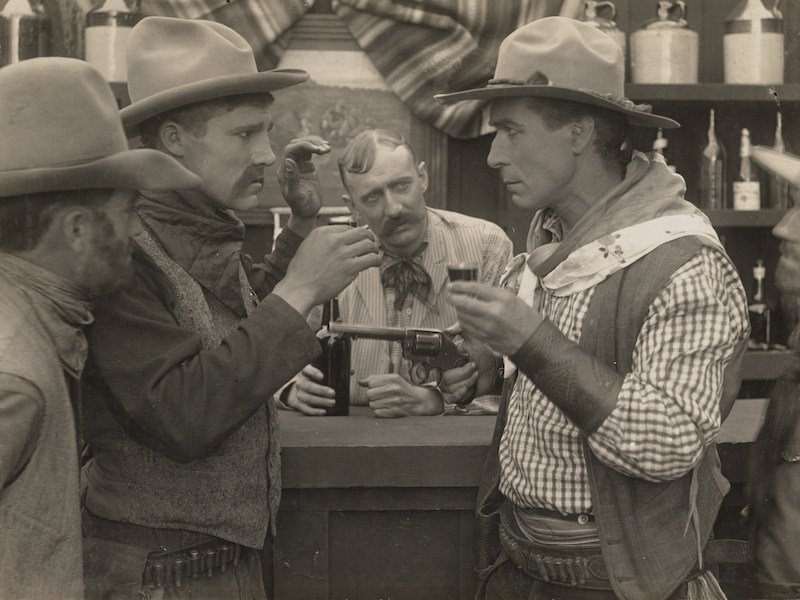“BAD BUCK” OF SANTA YNEZ
William S. Hart (US 1915)
“Bad Buck” of Santa Ynez is the tenth two-reel drama of 17 Hart directed at Inceville, filmed in February 1915 just after production of the feature The Darkening Trail. Here he works with newly hired Ince scenarist J. G. Hawks on a rip-snorting tale of cowboy high jinks and sentiment, rough riding and tender gesture. Hart dies onscreen for the third time in his NYMPC career (after His Hour of Manhood and The Taking of Luke McVane), and Hawks supplies a worthy motive for draping the studio’s biggest box office star in a tragic ending: saving a child’s life.
Despite a whiff of inside humor in the title (Inceville was located just east of Santa Ynez Canyon) and some levity in the intertitles, Hart plays the drama straight and sincere. After a brief glimpse of a pioneer family struggling in their covered wagon, “Bad Buck” Peters is cut in, clattering into town along a wooden sidewalk, filling the screen with the bold graphics of his checkered shirt and darting piebald horse, very like the energized cowboy paintings of Hart’s pal Charlie Russell. Inside the Red Dog Saloon, his macho drinking duel with the sheriff is choreographed in a strict pas de deux, played here with correct formality by Robert Kortman, one of the unit’s assistant directors. Buck wins, but incurs mortal enmity. His behavior suggests that he is often guilty of practical joking, not capital crime, but the result is unfortunate; the sheriff is a sore loser. Riding hell-for-leather out of town over the muddy, bleak landscape, “The Terror of Santa Ynez” just manages to escape a lynch-minded posse.
Scenes of the distraught pioneer family are intercut with saloon horseplay, laying out the contrasting story line of hapless Easterners in a wild and wooly West. Mother and child pray for Father, dead of his illness, and beg the escaping horseman for help digging a grave. Hart’s famous “soul fight” turn is expressed here by mise-en-scène more than facial expression. The plot operates on the 19th-century cultural standard that an innocent child, as a conduit of divine grace, can sway the blackest heart. And so she does.
The child Honey is played by eight-year-old Thelma Salter, in pictures since 1913. She had been seen the year before as a “Keystone Kid” in a dozen one-reel comedies for Sennett, worked often in Inceville for other directors, and appeared in Hart’s second film, Jim Cameron’s Wife. He would cast her later in The Disciple and Selfish Yates.
Moved to assist, Buck offers his cabin to the two unprotected women. Honey, obedient and helpful, is picking flowers after fetching water when she is bitten by a rattler. The drama, without close-up camera coverage of a striking snake (perhaps a censorship concern?) is constructed through editing. The fat rattlesnake, seen in close-up, is paired with medium shots of the reptile lurking under the flower bush. Salter mostly mimes the snake bite, as the creature’s motion is seen only from a distance. A close-up of bite marks on her leg, and a big commotion when Buck kills the snake, shooting and splashing about, sells the scene.
The horse-riding sequences in “Bad Buck” of Santa Ynez are glorious. A big posse crosses the screen in a strong diagonal movement. Buck, returning to town, is depicted in a crisp silhouette across the rugged horizon. This staple element of the western is used generously here, not as filler, but to develop plot. Buck tracks his pursuers seen on the trail below from a high mountain vista while he whittles a doll for Honey. Later, his silhouetted ride back to town to fetch a doctor is tracked by the sheriff, who plots an ambush.
The redeeming power of an innocent is given full play in the closing scene as Buck, mortally wounded, delivers the doctor to save Honey, then drags himself with his last ounce of strength to her bedside for one last affirmation of his good soul – a bit Victorian in stagecraft, but part and parcel of Ince storytelling. Mother holds back the crush of the vengeful posse at the cabin door with a ladylike gesture of restraint as the camera pans to Buck, in peaceful death at her child’s side. “Bad Buck” of Santa Ynez is a strong iteration of Ince’s formula for Hart: peril and pathos expressed in the particulars of a Western milieu.
Diane Koszarski


regia/dir: William S. Hart.
sogg/story, scen: J. G. Hawks, Thomas H. Ince.
cast: William S. Hart (“Bad Buck” Peters), Fanny Midgley (Mary Gail), Thelma Salter (Little Honey Gail), [Robert Kortman (Sheriff)].
prod: New York Motion Picture Co., supv: Thomas H. Ince.
dist: Mutual/Kay-Bee.
uscita/rel: 21.05.1915.
copia/copy: DCP; 23’27”; did./titles: ENG.
fonte/source: Library of Congress Packard Center for Audio-Visual Conservation, Culpeper, VA.




